Webex and Microsoft Teams are two of the most popular video conferencing platforms on the market. Businesses of all sizes use them to stay connected with employees, customers, and partners. Each product has features like group chat, file sharing, and video conferencing that streamline communication between remote workers, office colleagues, and clients.
But which video conferencing software is better for your business? In this blog, we’ll compare Webex and Microsoft Teams side-by-side to help you decide.
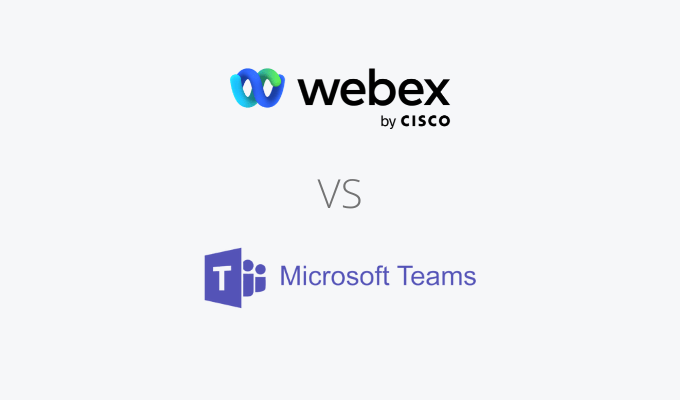
Webex and Microsoft Teams Compared to the Best
Based on our research, Webex is one of the best video conferencing software products on the market. It’s the best for hosting accessible webinars and has a wide range of features, making it ideal for businesses of all sizes. Click here to sign up for free.
And if you want to see what else is out there, here are our picks for the best webinar software:
- Livestorm – Best all-in-one-combo of webinars and virtual meetings
- WebinarJam – Best for hosting all types of webinars
- ClickMeeting – Best for beginners
- Demio – Best for marketing and sales
- Webex – Best for hosting accessible webinars
- BlueJeans – Best for scaling live webinars beyond 500 attendees
- EverWebinar – Best set-it-and-forget-it webinars
- Vast Conference – Best budget-friendly option
- Zoom – Best for educational institutions
- BigMarker – Best for large virtual events
- Crowdcast – Best webinar platform for a built-in audience
- GoTo Webinar – Best for infrequent webinars
- MyOwnConference – Cheapest way to facilitate simultaneous webinars
- WebinarGeek – Best for GDPR compliance and/or EU audiences
If you’re interested in which might be the best solution for your business, check out our full reviews on the best webinar software here.
Webex vs. Microsoft Teams: High-Level Comparison
Brands may host webinars for all sorts of reasons—to generate leads, close sales, or onboard new employees. In many cases, they may also do it to engage their current customers, build brand awareness, or educate their audiences.
Webex is a leading enterprise solution for video calling, webinars, and online meetings. The companies that use WebEx are typically found in the United States in the Information Technology and Services industry. These companies usually have somewhere between 50-200 employees and $1M-10M in revenue.
Microsoft Teams is a cloud-based collaboration tool that is part of the Office 365 suite. It offers features like chat, video calling, and file sharing. It is widely used in companies across the country, with 90% of the Fortune 500 using Microsoft Teams.
Products and Services Offered by Webex and Microsoft Teams
Both Webex and MS Teams are comparable in their service offerings. Teams is part of the Office 365 ecosystem, so many of its features revolve around document collaboration. Webex, on the other hand, is known for its video capabilities—particularly its webinars.
For businesses that use Outlook and Microsoft Office, Teams is a logical choice. It’s integrated with all of the applications that employees are already using on a daily basis. For example, users can schedule a meeting in Outlook and automatically add the details to Teams.
Other features we love about Microsoft Teams include:
- The ability to create private channels for smaller groups within a team
- Integrations with over 150 apps, including Salesforce, Dropbox, and Twitter
- Live event broadcasting for up to 10,000 people with extension (meetings up to 1,000 participants)
- A mobile app that lets users join meetings on the go
Webex is a video conferencing app that has been around for much longer than Teams. It offers a wide range of features for businesses of all sizes, including:
- High-definition video and audio on any device
- Shape recognition in video meetings
- Gesture recognition
- Real-time translation for over 100 languages
- The ability to join a meeting without downloading any software
- Webinar features like live broadcasting, on-demand playback, and registration forms
- Webinars with up to 10,000 participants (plus 500 cohosts and panelists).
And while it is not tailor-made for businesses that use Outlook and Microsoft Office, it does offer integrations with these applications. Additionally, its strategic partnerships with Apple, Google, Miro, and Slack give it a leg up over its competitors.
Company Health and Stability of Webex and Microsoft Teams
Microsoft was founded in 1975 and is a publicly-traded company with a market cap of $1.94 trillion as of September 2022. Microsoft Teams was first rolled out in 2017 and is currently used by over 270 million active users worldwide.
Webex was founded in 1996 and acquired by Cisco in 2007 for $3.2 billion. Since then, it has become one of Cisco’s key products. Currently, Webex has over 650 million active monthly meeting participants.
Large, stable companies back both MS Teams and Webex. However, Microsoft Teams is part of a much larger ecosystem (Office 365), which gives it an advantage in terms of market reach and overall stability.
Webex vs. Microsoft Teams Pricing Comparison
Webex and Microsoft Teams are different in their pricing structures. Both are free to use for individual users, and neither platform requires you to make an account before attending a meeting, webinar, or video call.
Webex does have a free version for businesses, but it is fairly limited in terms of features and functionality. Microsoft Teams’ free version is also quite limited, but a few dollars per user per month extra buys you lots more functionality. And if you already use Office 365, Teams comes free to use with each user.
Pricing Structure of Webex and Microsoft Teams
Microsoft Teams is included in all Office 365 plans, which start at $6 per user per month. For $12.50 per user per month, each user has access to Office 365 Standard, which includes Microsoft Teams, and a host of other features like Word, Excel, PowerPoint, OneDrive for Business, and more.
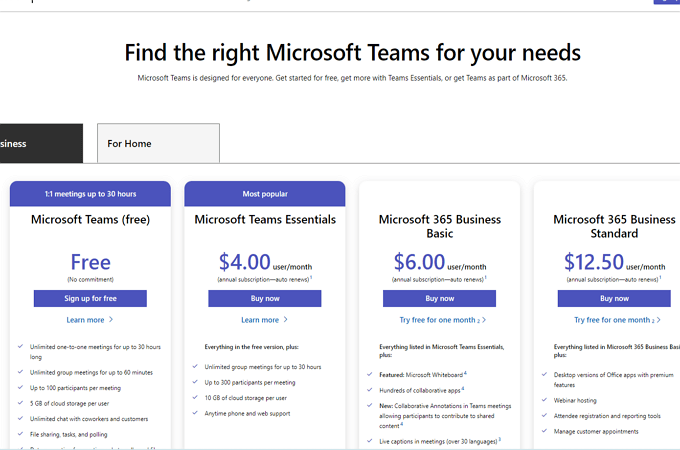
If you just want to use Teams, you can do that as well. For most individuals, the free version of MS Teams is more than enough. But if you need to host group meetings, large meetings with hundreds of people, or save lots of meeting data on the cloud, $4 per user per month will get you there.
Webex has a free version as well, and its features are robust for a free application. It allows for breakout rooms, video messaging, and meeting recordings on local storage. For individual and small businesses, Webex’s free version is certainly more than enough.
However, if you need enterprise-level features like site administration, single sign-on (SSO), or custom branding, you’ll need to sign up for one of Webex’s paid plans. Their Business plan starts at $25 per user per month and includes all the features of the free plan and many more. And if you need to use Webex’s professional services for a large organization, their Enterprise plan is customizable based on users’ needs.
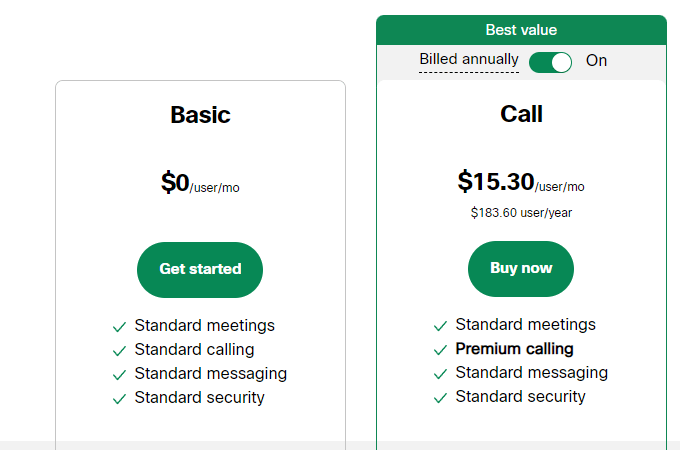
Cost Comparison of Webex and Microsoft Teams
As we previously mentioned in the above section, both Webex and Microsoft Teams charge per user per month and both have useful free versions of their applications. Where they differ is in how much they offer—and at what price they offer it.
Microsoft Teams’ free plan is similar to that of Webex, but it also includes polling and other interactive features that are only available in Webex’s paid plans. The free version also allows users to chat with coworkers and customers and share unlimited files.
If you upgrade to the paid version, it is only $4 per user per month and gives you many features that are not available in the free versions, such as recording meetings and storing them on the cloud, larger meeting sizes (up to 300), and more.
Webex’s paid plans are far more expensive than Microsoft Teams’s. At $25 per user per month, their next tier is over six times as expensive as Teams’ paid plan. Granted, it does offer quite a few features that are not available in Teams, such as unlimited calling to any phone number, post-meeting transcripts, and advanced security features. But unless your organization absolutely needs those enterprise-level features, it is hard to justify the cost difference.
Trials and Guarantees for Webex and Microsoft Teams
Neither Teams nor Webex offers free trials for their paid plans. The policies for canceling your subscription to Microsoft Teams depend on whether you are a new customer, which product you have purchased, and your domain selections.
To cancel your Webex paid plan, you’ll have to do so thirty days or more before your service is set to renew. You will not be charged a fee for canceling early if you have an annual subscription, but you will need to pay the rest of it before being downgraded to the free plan or dissolving your account.
If you cancel your subscription early, Microsoft Teams will not issue a refund and you will still owe them the monthly fee for that month. Webex will also not issue a refund if you cancel your subscription early.
Webex vs. Microsoft Teams: Core Criteria Comparison
Now that we’ve looked at the key features, costs, and policies of Webex and Microsoft Teams, it’s time to compare them side-by-side on some core criteria. To see how Webex and Teams stack up against their competitors, check out our top picks for the best webinar software here.
Affordability: Microsoft Teams Wins
Affordability is important for small businesses and individual users who don’t have a lot of money to spend on software. If a small company with limited resources overspends on software, it can put them in a difficult financial position.
Microsoft Teams is the clear winner when it comes to affordability. At $4 per user per month, purchasing Teams for your employees is a minimal cost. And if you include Office 365 with it, you get access to Microsoft’s entire suite of features for half the cost of each Webex seat.
User Experience: Webex Wins
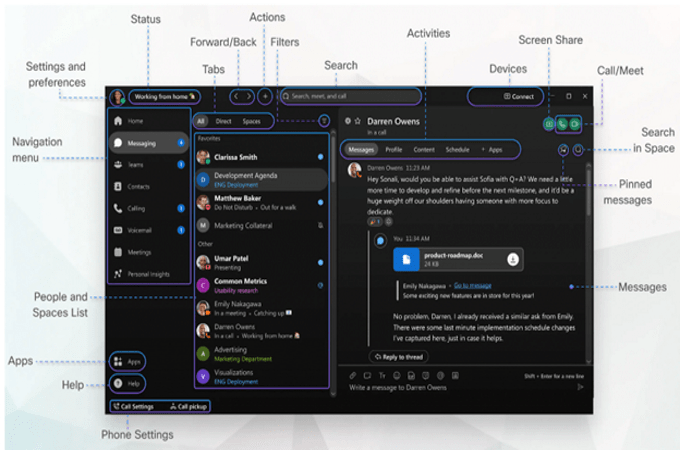
Choosing software with an excellent user experience is crucial for your business because it will save time on employee onboarding and ensure that your employees will actually want to use the software.
Judging the UX of a video conferencing application can be difficult because most of them are similar. However, the accessibility Webex provides for certain buttons makes it come out on top.
Additionally, the user interface for Webex is slightly more intuitive and polished. The Microsoft Teams UX is very basic and could use an upgrade. It’s not a huge difference, but it is noticeable.
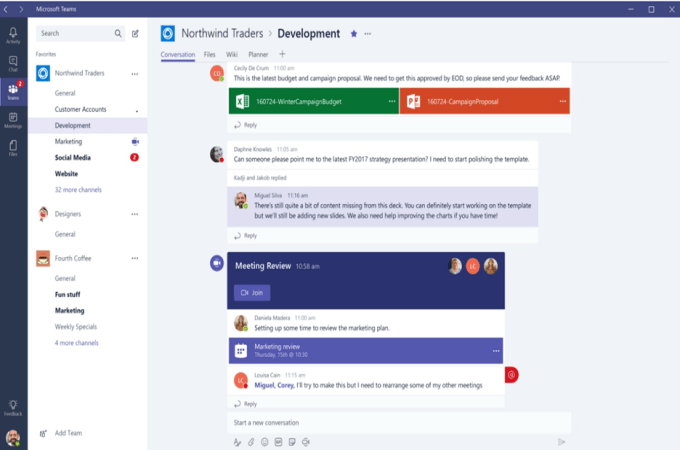
Third-Party Integrations: Webex Wins
Your company uses more than just one tool, and it’s important that each tool you use can talk to each other. Without the ability to use your tools together, data, tasks, and processes are siloed in different software, making it more difficult for your employees to do their jobs.
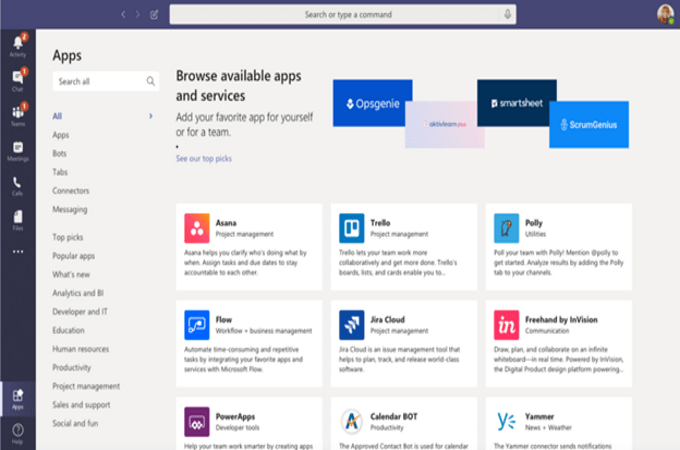
Business app integrations are the industry standard these days, and most apps integrate with each other no matter which product you choose. One of the main selling points of Microsoft Teams is that it works seamlessly with other Microsoft products. This is a great feature if your company already uses Microsoft Office 365. However, there is no reason to use Teams over any other service if you aren’t already using the company’s other products.
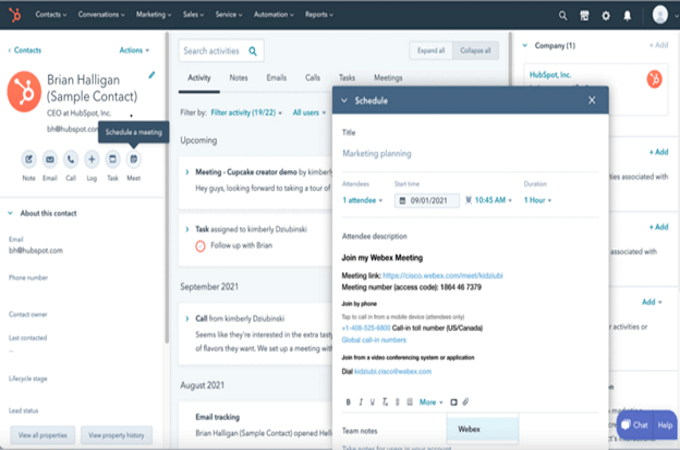
Webex, on the other hand, integrates perfectly with everything else. You can host meetings with Teams while using Google Suite or Apple Calendar, but it won’t be as easy because it’s designed to work with other Microsoft products. Since Cisco itself does not have the same kind of self-contained product offering, Webex does not have this issue—it integrates with everything.
Technology Offerings: Webex Wins
Having technologically advanced software that can meet the needs of all members of an organization is critical to running a successful business. AI assistance, meeting transcription, and multilingual support are just a few of the features that are becoming standard for modern businesses.
Microsoft Teams has lots of basic technology offerings like video and audio conferencing, content sharing, and co-authoring. You can also send unlimited chats, files, and more with Microsoft Teams. Best of all, these features are easy for anybody to use, making employee onboarding a breeze.
But Webex offers many additional technological features that MS Teams does not. It enables users to send video messages with Vidcast, join video meetings from any device with Click-to-Join, and hold virtual events with Webex Events.
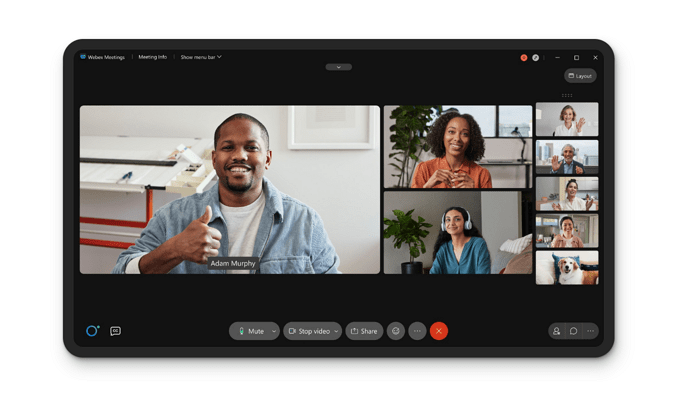
Webex also has features that are geared towards enterprise users, like site administration and single sign-on (SSO). These make it easy for IT departments to manage and monitor user activity.
Webex also gives you AI assistance during meetings and webinars and automatically transcribes and translates your meetings in 100+ languages.
Meeting Sizes: Webex Wins
Most teams have minimal group meeting requirements that just about every product can meet. But for large companies that want to host webinars, larger meetings with other offices, or company-wide events, the ability to host several hundred users is critical.
Microsoft Teams allows up to 300 users for its highest-paid plan. And while that should be plenty for most organizations, enterprise companies that want to deliver companywide training or virtual events might want even more participants.
To do this with Microsoft Teams, those companies would need to purchase Live Events, which is a separate product offering with a different pricing structure. This product allows users to host up to 10,000 attendees, but many organizations don’t need that level of capability and are turned off by the added cost.
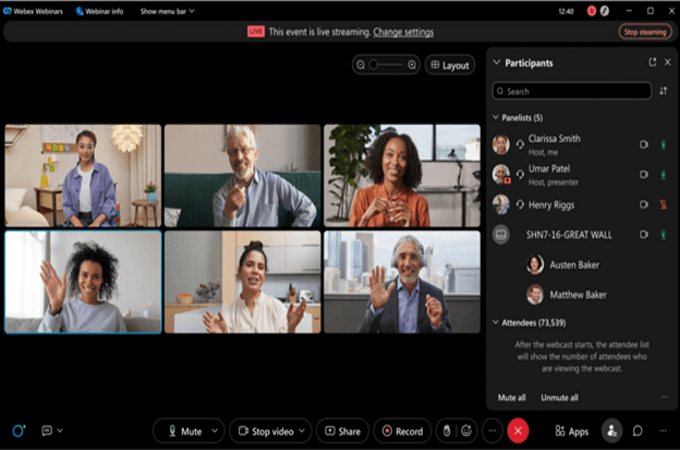
Webex, on the other hand, offers plans that support up to 1,000 participants without needing to purchase a separate product. This makes it the clear choice for enterprise companies that need to host large virtual events.
Security: Webex Wins
Security is one of the most important parts of any video conferencing solution. After all, you’re trusting the app with sensitive company information. And if your team members use it to collaborate on everything work-related, you need to know that their data is safe.
Thanks to its end-to-end encryption, Webex is one of the most secure video conferencing platforms available. And since security is always a top concern for enterprise companies, this makes Webex the better choice.
Microsoft Teams also has end-to-end encryption, but it is not available for all of your calls and you need to remember to turn it on each time. This can be a hassle for busy employees who might forget to do this, which could lead to security breaches.
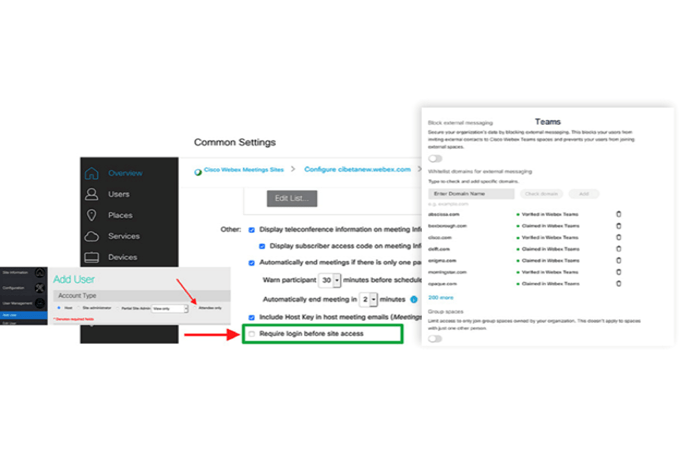
In addition, Webex offers other features that make it more secure than Teams, like password protection, expiring meeting links, and the ability to lock meetings. These features make it harder for unauthorized people to join your calls and listen in on sensitive conversations.
Final Verdict: Webex Wins
Webex is the better option for those needing enterprise-level features and security. While Microsoft Teams is a great product, it is not the best choice for companies that need a robust video and webinar tool. It certainly works for most functionalities and organizations.
If you need a basic solution and you already use Microsoft Office, Teams is a good choice. But if you want a comprehensive video conferencing tool, Webex is the way to go.
from Quick Sprout https://ift.tt/9GMgP15
via IFTTT
No comments:
Post a Comment